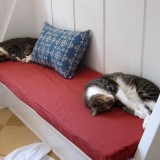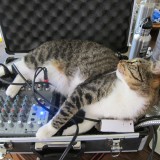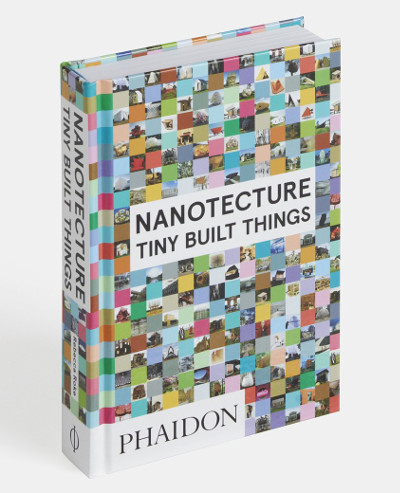
We have two senior cats. One of those cats, Buck, has had a lot of health issues over the years, including heart problems, digestive issues and a blood clot. He’s likely on eight of his nine lives and can add another health problem to his long list: hyperthyroidism.
Thankfully this can be fixed with an expensive radioactive iodine therapy. He’s such a sweet cat that I thought we owed him a chance, plus the alternative treatments, a special diet or pills, just won’t work well for him.

Waiting for food.
Radioactive iodine therapy involves one shot and several days at a treatment facility to let the radioactivity levels subside. It doesn’t cause the cat any pain, but they can’t be around people or other animals for a few days. When he gets back we have to minimize contact with him for awhile and scoop out his litter into a bucket that has to sit for a few weeks before we can dispose of it.
I’ve never been to a vet as organized and efficient as the folks doing this treatment, Advanced Veterinary Medical Imaging in Tustin. They send a daily spreadsheet update, call frequently and there’s even a webcam in Buck’s cage which has allowed us to watch him beg for food and hide from the vet techs. I really wish our human health system in the country spent a little more money on communicating with patients and families. It would make life easier for everyone including our overworked doctors and nurses.
Mr. Buck came to us over a decade ago as a kitten from a neighbor who found him unconscious in a driveway. I feel privileged to have lived with this feline in all his ups and downs and when the time came to make the decision on this treatment I didn’t think about it long. We’re fortunate to be able to afford it and I felt an obligation to make whatever time we have left with him as comfortable as possible.
Until this absence this week, I didn’t fully realize what a presence he is, the way he bosses the dog, the other cat and even us around. The house is haunted by his absence, by the way he bangs on the window by the bed to wake me up at 5:30 for breakfast, his nocturnal zooms and his conspicuous midday napping.




Some years ago, our old cat Lucky was diagnosed with hyperthyroidism. We arranged for her thyroid to be zapped (a medical term) at North West Nuclear Medicine for Animals in Vancouver. The price, although high, was reasonable and included her airfare from where we lived up the coast to Vancouver Airport, her being picked up at the airport, her treatment then her return to the airport and flight back.
We had a telephone call with the clinic’s vet – a very pleasant lady – who gave us details of the treatment and administrative arrangements. She then asked us if Lucky had any favorite music! In all our years of owning cats, it had never occurred to us that they had musical favorites so, of course, we told her The Brandenburg Concertos. No, not really!
A few days later, the clinic called us back to say that Lucky’s hyperthyroidism was only marginal, so we should probably delay treatment for a couple of months.
In the meantime, we had read that tuna, being near the top of the food chain, contained high levels of heavy metal in its flesh and that people should be careful to limit tuna consumption. As Lucky loved tuna and ate at least two cans a week, we checked into this further. It turned out that one of the symptoms of heavy metal toxicity was hyperthyroidism. We immediately stopped the tuna and replaced it with fish, like herring and sardines, that were lower down the food chain. Her hyperthyroidism went away over a month or so and never returned.
It pays to do the research. In our case, several thousand dollars!
Cool story about Lucky…he was indeed Lucky to have had you for parents. I’m hoping Buck will fair well after his treatment!
Fantastic! In our case, many years ago, our vet suggested not feeding our cats any fish so we can probably rule out mercury. That said, his vet and the folks who zapped him both did a hyperthyroid check before beginning treatment.
Such a touching story. Thank you for sharing. I never knew Buck’s Origin Story.
I agree entirely with your comment about human health care in this country. I’ll add that, if I’m ever hospitalized, I hope providers will be prepared for me to beg for food and I hope for a space in the room where I might hide from technicians.
Lololol. Cat lovers and health care advocate super powers unite!
I was interested as well in that perspective… that we receive calls from vet clinics—they reach out— to assure us and connect us but I’m on hold for two hours to get access — reaching into human health care to get info. It’s a void.
Hopefully a web cam too!
Coincidence, as I’m thinking of doing this for my cat, but I am more concerned with the two-week period following treatment. Like how will I avoid contact more then ten minutes a day, in my tiny house? In my state, the litter must be flushed, will my old pipes handle that? I’m a bit neurotic, which does not help with this decision, but she is a young cat to have hyperthyroidism so it’s looking like the best option.
Good luck to your kitty!
Hey Val, The post procedure period has been easier to deal with than we expected. He’s locked out of our room at night and we kind of avoid him during the day. As for the litter we’re putting it in a bucket and holding on to it for a few months (I think it’s 3 months?) while the radioactivity diminishes and it can go in the trash. Our 104 year old pipes could not handle flushing, I’m afraid. Cat is doing great and, despite the steep price tag, it’s probably more cost effective in the long run than pills. Best of luck with your kitty.